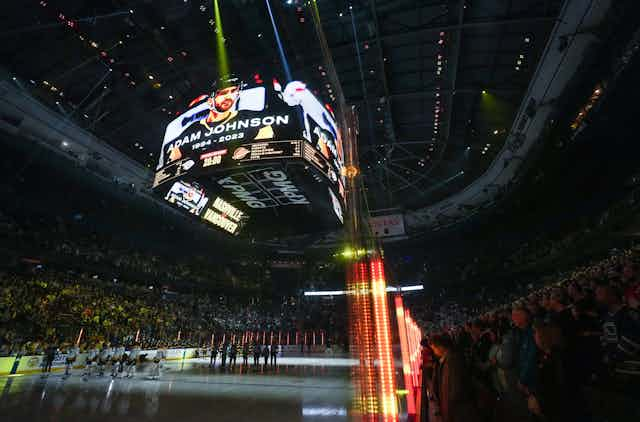Hockey player Adam Johnson’s death from an on-ice skate blade incident was jarring and tragic. Johnson passed away on Oct. 28 after being cut in the neck by another player’s skate blade during a professional hockey game in Sheffield, England.
Understandably, a vigorous debate has ensued about whether neck guards should be made mandatory beyond the minor hockey league level. Some leagues quickly responded by implementing neck guard policies and others might follow once the issue has been filtered through the proper channels.
Hockey organizations have been responsive to physical injuries in recent years, and the adoption of life-saving protective equipment is certainly important, but this is not the only conversation we should be having.
Organized hockey at all levels needs a strategy for unseen injuries as well. They’re often the last to heal, if they do at all.
Lasting impacts of traumatic events
Traditionally, hockey culture — the norms and behaviours that guide the sport — has shown a preference for attributes like mental toughness over emotional vulnerability. This practice can damage athletes when they’re confronted with traumatic events, which are more frequent than many realize.
I have spent the last four years exploring team tragedy in the youth hockey context. Alongside research team members Todd Loughead, Owen Bravo, Joe Miller and Shaun Smith, we have been working to understand why organized youth hockey has mishandled team tragedy, the consequences of untreated trauma and, most importantly, ways to improve support systems for young athletes.

To that end, we conducted almost 30 in-depth interviews, starting with survivors of the Western Hockey League’s Swift Current Broncos bus crash that took place in Swift Current, Sask. in 1986. The crash claimed the lives of four players (Trent Kresse, Scott Kruger, Chris Mantyka and Brent Ruff) and the survivors received no formal support from their head coach and general manager, Graham James.
James, in his role as team gatekeeper, employed the time-honoured practice of closing ranks in the face of adversity. Given James’s later conviction in junior hockey sex assaults against players he coached in the 1990s, this “closing ranks” response seems not only outdated, but profoundly disturbing.
Players, too concerned about appearing weak, didn’t self-advocate for resources. They didn’t want to appear as “damaged goods,” particularly when they were so close to their childhood NHL dreams. Our interviews revealed that some players turned to substances to help cope with their survivor’s guilt and their unresolved mental turmoil. Others struggled because of their close relationships with their fallen teammates or because they had increased responsibilities that resulted from the deaths.
Players that were billeted — a reality of junior hockey — tended to fare worse because they were separated from their families, and their billet families often felt under-resourced to support them. Some players managed to sublimate their mental struggles while their hockey career lasted, but many experienced a significant, if delayed, reckoning in their late 30s.
Hope on the horizon
Hockey culture has drawn increased scrutiny in recent years for failing to modernize and address toxic masculinity in the sport. Recent troubling incidents involving Hockey Canada prove more can, and must, be done to improve the hockey experience.
Nevertheless, our interviews with youth hockey stakeholders demonstrate there is a clear desire to better support teams struck by tragedy.
A striking example of positive change is evident in the post-tragedy experience shared with us by Tim Barrie, director of hockey operations for the Ayr Centennials. When captain Eli Palfreyman collapsed during an intermission and died, the team and league insisted on supporting players with mental-health resources.
The team WhatsApp group chat demonstrated an environment where players and team staff felt safe to express love, sorrow and brotherhood. This stands in stark contrast to the experience of the Broncos, who largely suffered in silence.
The landscape surrounding mental health in youth hockey has changed. Some of this improvement is owing to likes of Bob Wilkie, a 1986 Broncos bus crash survivor that saw the system for what it was and knew it could be better. Wilkie founded I Got Mind, a program that helps young athletes and their families deal with mental illness, in 2008.
What remains elusive, however, is an emergency plan that youth hockey organizations can implement once tragedy occurs.
Supporting player mental health
At present, responses to tragic events in Canadian hockey have been reactive and improvisational. Representatives from the Ontario Minor Hockey Association and Hockey Canada expressed that resources are available for member leagues and clubs, but there was some doubt that affected groups would know how to access them.
The money provided by Hockey Canada’s insurance for grief counselling is capped at $1,000 per team, which doesn’t go far in our inflationary times.
To complicate matters, Hockey Canada provides the money but not the expertise, leaving tragedy-stricken teams to search for their own grief counselling providers who can offer timely support. Given wait times and the scarcity of therapists, particularly in rural areas, this solution seems problematic.
Minor hockey associations that operate in the not-for-profit space and rely heavily on volunteers are particularly shorthanded. They depend on the kindness of the communities they serve to offer resources and expertise to players.
A recent change in leadership and direction shows Hockey Canada is serious about winning back the trust of the public. As such, the governing body should embrace this opportunity to properly resource hockey teams in crisis by creating a mental-health unit that can be deployed across the country.

